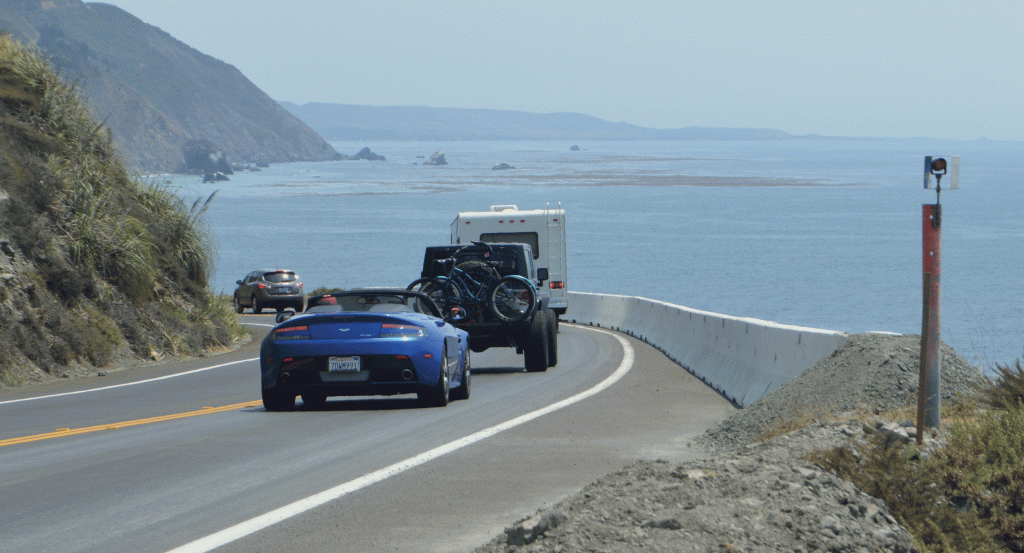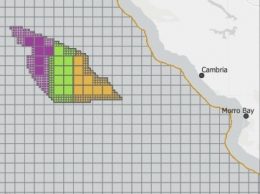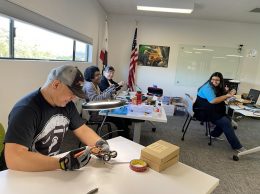Highway 1 open for business and tourism rebounds

Travelers drive south on Highway 1 through Big Sur toward San Luis Obispo County on Aug. 11.
Shops and stops along Highway 1 have experienced a late summer surge in the few weeks following the historic coastal route’s mid-July reopening. Now merchants are wondering how long the good times will roll.
The famed highway along the Central Coast was closed from just north of Ragged Point in San Luis Obispo County into Big Sur for 18 months after the Mud Creek slide dumped 15 acres of debris on the area and reshaped the coastline.
The $54 million project to repair Highway 1 was slated for a mid-September opening, but moving the timeline up a couple months allowed the Central Coast to catch more peak summer business.
It has been “an absolute deluge,” said Cambria business owner John Linn.
“We weren’t completely wrecked because of the closure, but it sure didn’t do any good,” said Linn, who owns the well-known brand Linn’s Fruit Bin. “When it reopened it was a breath of fresh air. The feeling is that it is like it was in years previous.”
The closure hit especially hard for Ragged Point, San Simeon and Cambria — all stops along the iconic ocean drive. Linn said that he was aware of some seven or eight businesses in Cambria that shut their doors directly because of the closure.
Newer businesses, especially, faced more challenges, said Linn, which could have been caused by anything from unsecured finances to less public awareness. He also identified a trend echoed by local business owners along the coastline: a recognition of his region as a destination, which continued to draw travelers even as the area struggled.
Jan Lewis, owner of Sweet Offerings fudge shop in Cambria, said traffic in her store has not yet returned to the levels she saw last summer, but that the area “was very slammed” immediately after the reopening of Highway 1.
Lewis, who has been in business since 2007, said she never considered closing up shop even as she watched several other nearby shops do so.
As tourism attractions saw decreases in visitors, businesses saw declines and hotel rates were slashed, the small, ocean-side communities persisted.
“When I first opened my business,” Linn said of his 41-year-old company, “in those days, when highways closed you might as well close your doors. It finished you.” Now, he pointed out people are more eager to visit Cambria because of its unique reputation.
Many small business owners reflected this attitude.
“I’m sure we lost business, but not a lot. Because Morro Bay has become a destination in and of itself,” said Terry Cross, an employee at Farmer’s Kites Surryes & More in Morro Bay.
Jennifer Little, the tourism manager for Morro Bay, said that although international tourism was down by 10 percent while Highway 1 was closed, tourism from within the county was up 10 percent, and transient occupancy tax grew slightly because of targeted marketing in domestic areas.
International travelers offer a critical boost to the tourism economy of the region, often staying longer in the area — anywhere from three to seven nights — and visiting between high and low seasons, she said.
Little’s team, along with tourism groups from San Simeon and Cambria and the nonprofit Visit SLO Cal, were involved in planning and hosting the Dream Drive, an event that brought together 80 international journalists for a trip, which included driving a stretch of Highway 1, staying in local hotels and meeting business owners.
The event commemorated the highway’s 84th anniversary, but was also geared toward catching the attention of the international community.
“Visit SLO Cal brought in all these journalists from around the world to tell the world that we’re open now,” said Stacie Jacobs, a key organizer of the event and chief strategist at Solterra Strategies tourism marketing agency.
Matthew Ramey, assistant general manager at Ragged Point Inn and Resort, said that business was about “four times higher” than it had been during the closure. Occupancy rates at the resort, which is located just south of where the closure took place, jumped from 65 percent to 100 percent, and smaller shops, such as the hamburger and ice cream stands, were reopened as the resort returned to operating at full capacity.
“We had mixed thoughts (about anticipated traffic volumes),” said Ramey. “We weren’t 100 percent sure what it was going to be — whether it was going to be a slow increase in business or the explosion that it was — but we’re very happy with how it turned out.”
In San Simeon, where hotel occupancy rates had been down by around 30 percent, Mark Hucek, general manager of the Cavalier Oceanfront Resort, said the Cavalier’s two properties have run at 90 percent occupancy rates since the reopening with 100 more meals served per day.
Getting the highway open early was particularly fortunate for businesses fighting to stay open in the area.
“There were people that were teetering,” Hucek said, adding that if the closure had lasted a few more months some smaller businesses in San Simeon may not have made it.
At Hearst Castle, an attraction that draws hundreds of thousands of visitors annually to its location in San Simeon, visitor numbers increased 2 percent since the reopening, and 10 percent in the first 11 days of August — compared with decreases of 14 to 20 percent during the closure.
Dan Falat, the California State Parks district superintendent, said his team is optimistic of continued growth at Hearst Castle, continuing to plan for full-capacity tours. This week, the iconic pool will finish being filled after being empty for five years, and the $5.4 million dollar tiling and restoration project officially wraps up in the next couple weeks.
Rates at the Silver Surf Motel in San Simeon, which were cut in half during the closure, will likely return to normal soon as the demand continues to pick up, said Assistant Manager Armando Valencia. His family owns and operates the restaurant next door and a few other businesses in the area, and he said they are all very thankful to have the highway back.
Across the street, Hucek echoed his sentiments: “The day they took the barricades down, we picked up 30 rooms.” Highway 1, he added, “is the lifeblood of this community.”
• Contact Annabelle Blair at [email protected].










